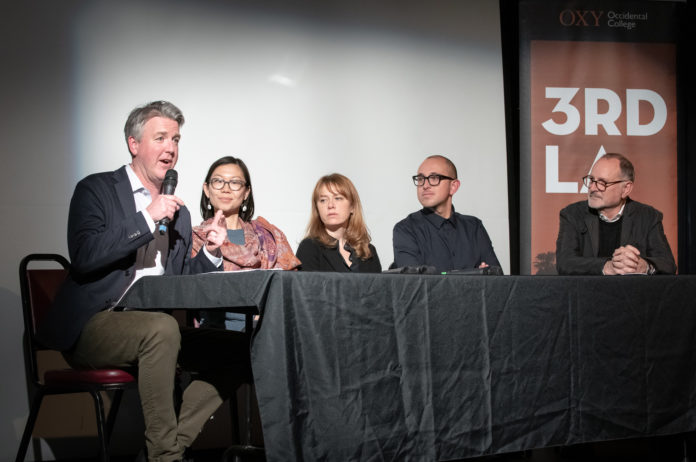
Occidental College’s “3rd LA Project” series began March 6 at the Barnsdall Gallery Theater in East Hollywood with a lecture titled “Is There An L.A. Sensibility? Place and Politics in Los Angeles Design.” During the event, speakers ranging from practicing artists and architects to a local city councilmember discussed the idea of a “Los Angeles sensibility,” defined as the characteristics that describe the city in terms of its architectural identity and its people.
Started in 2015 by Professor of the Practice and Chief Design Officer of LA Christopher Hawthorne, the 3rd LA series presents discussions regarding LA, architecture and urban design. In the past, lectures have covered topics such as urban housing, homelessness and the use of public space and featured guests ranging from Occidental professors to mayor of Los Angeles Eric Garcetti. The event represents an ongoing collaboration between the college and the mayor’s office, which co-sponsors the event.
Following opening remarks from Hawthorne, the lecture began with Councilmember Marqueece Harris-Dawson discussing the ongoing Destination Crenshaw Project in the Crenshaw district. According to Harris-Dawson, the project came in response to a light-rail development that would bisect the Crenshaw district and potentially contribute to gentrification and the displacement of residents. In order to balance the need for public transit with preserving the historic character of Crenshaw as a predominantly black neighborhood, the project promotes public works and art projects that embody the history of the district. Key aspects include plans for a large outdoor mural celebrating prominent African Americans, numerous parks and an amphitheater, all featuring artwork from local African-American artists. Based on the themes of “improvisation,” “firsts,” “dreams” and “togetherness,” the project seeks to assert Crenshaw as a destination and space that both modernizes its infrastructure while also celebrating its history.
“Crenshaw now is a very strong African-American community that can be a destination for Angelenos and the world,” Harris-Dawson said.
After Harris-Dawson finished speaking, Hawthorne introduced the next speakers: LA Times staff writer Carolina A. Miranda and artists Rosten Woo and Ruben Ochoa. During a discussion moderated by Miranda, artists Woo and Ochoa discussed their works. While their mediums differ — Woo utilizes graphic design while Ochoa utilizes primarily sculpture and murals — both displayed particular interest in the boundaries that define LA.
For Woo, this manifests as work that explores the boundaries in LA created by bureaucracy and zoning laws, and visualizing them in a way that can be understood by the everyday individual.
“With my work, I want to have a dialogue between expert and non-expert, governed and governor,” Woo said.
Ochoa focuses more on the physical boundaries that define LA. Speaking to the audience, Ochoa discussed a mural project of his that repurposed sections of the I-10 interstate by creating murals which emulate the natural life hidden behind the walls.

Next was artist and photographer Janna Ireland, who discussed the work of African-American architect Paul Revere Williams. Ireland built her talk around a series of photographs Ireland took of Williams’ many projects in the LA area, highlighting the tensions underlying his work. According to Ireland, the series juxtaposes Williams’ private works for white celebrities such as Frank Sinatra and Lucille Ball and his public projects such as the First African Methodist Episcopal Church, which were open to all regardless of race or socioeconomic status. For Ireland, the projects call attention to Williams and his work, which she believes have not received due recognition. Furthermore, she seeks to acknowledge the range of his works, between his private projects for white patrons and public projects and how they relate to race in LA.
The event culminated in a roundtable discussion moderated by Hawthorne and featuring four guest architects: Helen Leung, Elizabeth Timme, Frederick Fisher and Christopher Torres. Each offered their own take on the topic of the LA sensibility in relation to their own art.
According to Leung and Timme, both of the architectural firm LA Más, the Los Angeles sensibility represents an attitude that combines practical design purposes with engaging architectural designs. Timme said she and Leung design new low-income housing developments that provide affordable housing while simultaneously upholding the architectural legacy of LA.
“Affordable housing shouldn’t look affordable,” Timme remarked.
Torres and Fisher both noted that ideas of time figure heavily into the idea of the LA sensibility. According to Torres, a key part of LA’s architectural identity comes from the tendency to look to both the past and the future for inspiration.
In closing the event, Hawthorne spoke once more to the audience, reflecting on the guiding question of the evening. According to Hawthorne, seeking a single, defining LA sensibility or architectural identity is an exercise in futility. As the lectures preceding him showed, the architectural character of the city can be approached from angles that consider topics such as historical preservation, race and zoning laws.
“There is no single LA sensibility,” Hawthorne said. “There never will be.”
Reflecting on the lecture, Urban and & Environmental Policy student Grace Sponaugle (senior) said she enjoyed the event’s broad approach in considering LA’s architectural identity.
“I really appreciated how the lecture had a diversity of voices, having both artists and architects,” Sponaugle said.
The 3rd LA lecture series continues March 27 with “Strange Beauty: Making Sense of LA Architecture in the 1980s and 1990s” at the Ahmanson Auditorium in Downtown Los Angeles.
![]()


































